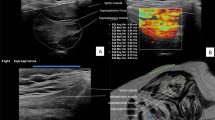Abstract
Ultrasound elastography (UE) is a new ultrasound-based imaging technique that provides information about elasticity and stiffness of tissues. This cross-sectional study aimed to identify the diagnostic importance of UE in supraspinatus impingement syndrome. Forty-one subjects, aged 38–70 years, were included in the study. UE was used to determine the elasticity of the supraspinatus muscle. The strain ratio was calculated as the evaluation criteria to measure the elasticity of the muscle. High strain ratio indicated low elasticity. The measurements were made by the blinded radiologist while the patients sat with their shoulder in a neutral position. The diagnostic value of the strain ratio was evaluated using the receiver operating characteristic (ROC) analysis. The mean strain value of the supraspinatus muscle on the intact and pathological shoulders determined by UE was 0.74 ± 0.33 and 0.31 ± 0.24, respectively. A low strain ratio value in the supraspinatus muscle on the side with impingement syndrome was measured. When the test variable was evaluated as “strain ratio” according to ROC curve analysis, it was found to be above the reference line [0.849 (> 0.5)] (P = 0.00). When the cutoff value was selected as 0.495, the sensitivity and specificity were found to be 75.6 and 78% (the strain ratio value > 0.495), respectively. Measurement of strain ratio with UE can be used as a noninvasive, inexpensive, and practical diagnostic test for the shoulder impingement disease.


Similar content being viewed by others
References
Beirer M, Imhoff AB, Braun S (2017) Impingement syndromes of the shoulder. Orthopade 46(4):373–386. https://doi.org/10.1007/s00132-017-3402-x.
Neer CS 2nd (1983) Impingement lesions. Clin Orthop Relat Res 173:70–77
Harrison AK, Flatow EL (2011) Subacromial impingement syndrome. J Am Acad Orthop Surg 19(11):701–708. https://doi.org/10.5435/00124635-201111000-00006
Xiang X, Yan F, Yang Y, Tang Y, Wang L, Zeng J, Qiu L (2017) Quantitative assessment of healthy skin elasticity: reliability and feasibility of shear wave elastography. Ultrasound Med Biol 43(2):445–452. https://doi.org/10.1016/j.ultrasmedbio.2016.10.002
Hou SW, Merkle AN, Babb JS, McCabe R, Gyftopoulos S, Adler RS (2017) Shear wave ultrasound elastographic evaluation of the rotator cuff tendon. J Ultrasound Med 36(1):95–106. https://doi.org/10.7863/ultra.15.07041
Krepkin K, Bruno M, Raya JG, Adler RS, Gyftopoulos S (2017) Quantitative assessment of the supraspinatus tendon on MRI using T2/T2* mapping and shear wave ultrasound elastography: a pilot study. Skelet Radiol 46(2):191–199. https://doi.org/10.1007/s00256-016-2534-0
Muraki T, Ishikawa H, Morise S, Yamamoto N, Sano H, Itoi E, Izumi S (2015) Ultrasound elastography-based assessment of the elasticity of the supraspinatus muscle and tendon during muscle contraction. J Shoulder Elb Surg 24(1):120–126. https://doi.org/10.1016/j.jse.2014.04.012
Rosskopf AB, Ehrmann C, Buck FM, Gerber C, Flück M, Pfirrmann CW (2016) Quantitative shear-wave US elastography of the supraspinatus muscle: reliability of the method and relation to tendon integrity and muscle quality. Radiology 278(2):465–474. https://doi.org/10.1148/radiol.2015150908
Lewis J (2016) Rotator cuff related shoulder pain: assessment, management and uncertainties. Man Ther 23:57–68. https://doi.org/10.1016/j.math.2016.03.009
Ishikawa H, Muraki T, Sekiguchi Y, Ishijima T, Morise S, Yamamoto N, Itoi E, Izumi SI (2015) Noninvasive assessment of the activity of the shoulder girdle muscles using ultrasound real-time tissue elastography. J Electromyogr Kinesiol 25(5):723–730. https://doi.org/10.1016/j.jelekin.2015.07.010
Hatta T, Yamamoto N, Sano H, Itoi E (2014) In vivo measurement of rotator cuff tendon strain with ultrasound elastography: an investigation using a porcine model. J Ultrasound Med 33(9):1641–1646. https://doi.org/10.7863/ultra.33.9.1641
Hatta T, Giambini H, Uehara K, Okamoto S, Chen S, Sperling JW, Itoi E, An KN (2015) Quantitative assessment of rotator cuff muscle elasticity: reliability and feasibility of shear wave elastography. J Biomech 48(14):3853–3858. https://doi.org/10.1016/j.jbiomech.2015.09.038
Guo L, Zhang C, Zhang DD, Gao JH, Liu GH, Wang SQ (2016) Application of shear wave elastography in the evaluation of neck-shoulder myofascial pain syndrome. Zhongguo Gu Shang 29(2):142–145
Lee SU, Joo SY, Kim SK, Lee SH, Park SR, Jeong C (2016) Real-time sonoelastography in the diagnosis of rotator cuff tendinopathy. Shoulder Elbow Surg 25(5):723–729. https://doi.org/10.1016/j.jse.2015.10.019
Seo JB, Yoo JS, Ryu JW (2014) The accuracy of sonoelastography in fatty degeneration of the supraspinatus: a comparison of magnetic resonance imaging and conventional ultrasonography. J Ultrasound 17(4):279–285. https://doi.org/10.1007/s40477-014-0064-y
Author information
Authors and Affiliations
Corresponding author
Ethics declarations
The study was approved by the local ethics committee, and written informed consent form was obtained from all patients.
Disclosures
None.
Rights and permissions
About this article
Cite this article
Demirel, A., Baykara, M., Koca, T.T. et al. Ultrasound elastography-based assessment of the elasticity of the supraspinatus muscle in impingement syndrome: does elastography has any diagnostic value?. Clin Rheumatol 37, 1661–1665 (2018). https://doi.org/10.1007/s10067-017-3928-7
Received:
Revised:
Accepted:
Published:
Issue Date:
DOI: https://doi.org/10.1007/s10067-017-3928-7




